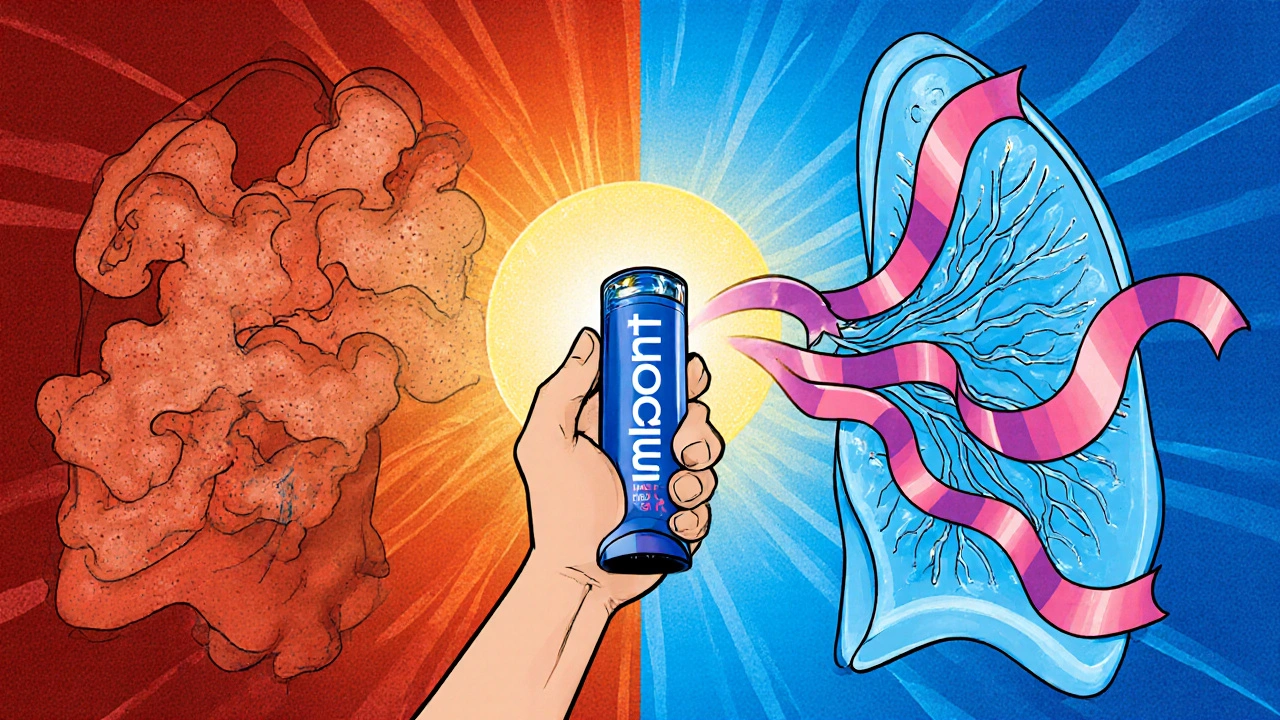
Asthma Inhaler Comparison Tool
Choose which inhalers to compare, select your preferences, and see how they match your needs.
This tool helps you understand the differences between Symbicort and other common asthma inhalers.
| Inhaler | Device Type | Dosing Frequency | ICS Component | LABA Component | Typical Daily Dose |
|---|
Recommendation
Your selected preferences and inhalers have been compared. Based on your choices, we recommend reviewing Symbicort and Advair Diskus as suitable options for your needs.
When it comes to managing persistent asthma, many patients and clinicians weigh the pros and cons of different inhaled combos. Symbicort is a prescription inhaler that pairs the inhaled corticosteroid budesonide with the long‑acting beta‑agonist formoterol. Together they reduce airway inflammation and keep the bronchi open for up to 12 hours, letting people breathe easier with twice‑daily dosing.
What makes Symbianct (Budesonide/Formoterol) tick?
Symbicort belongs to the ICS/LABA class - inhaled corticosteroid plus long‑acting β₂‑agonist. Budesonide tackles the root cause of asthma: inflammation. It binds to glucocorticoid receptors in airway cells, dampening cytokine release and mucus production. Formoterol, on the other hand, stimulates β₂‑receptors, causing smooth‑muscle relaxation that widens the airway lumen. The combination delivers both actions in a single puff, improving adherence compared with juggling separate inhalers.
Key benefits you’ll notice
- Twice‑daily dosing fits most daily routines.
- Fast‑acting LABA (formoterol) starts working within minutes, useful for early symptom relief.
- ICS dose (budesonide) is moderate, balancing efficacy with a lower risk of systemic side effects.
- Device - the HFA‑MDI (metered‑dose inhaler) provides consistent spray size and is easy to clean.
Common side‑effects and cautions
Like any inhaled steroid, budesonide can cause oral thrush, hoarseness, or cough if the mouth isn’t rinsed after use. Formoterol may trigger tremor, palpitations, or a slight increase in heart rate. Because LABAs can mask worsening asthma, doctors insist on a regular review and never prescribe a LABA alone. Pregnant or breastfeeding patients should discuss dosing with their GP, as budesonide is classified as FDA pregnancy category B.
Top alternatives on the market (2025)
When you ask, "What else works as well as Symbicort?" the answer depends on the patient’s age, inhaler technique, and insurance coverage. Below are the most widely prescribed alternatives, all of which pair a corticosteroid with a long‑acting bronchodilator.
- Advair Diskus - fluticasone propionate + salmeterol; dry‑powder inhaler (DPI) taken twice daily.
- Breo Ellipta - fluticasone furoate + vilanterol; once‑daily DPI.
- Pulmicort Respules - budesonide alone (no LABA); nebulized solution for children or severe cases.
- Dulera - mometasone + formoterol; MDI, similar dosing to Symbicort but with a different steroid.
- Beclomethasone/Formoterol (Foster) - DPI, lower steroid dose, useful for mild‑to‑moderate asthma.
Side‑by‑side comparison
| Inhaler | ICS Component | LABA Component | Device Type | Dosing Frequency | Typical Daily Dose (ICS) |
|---|---|---|---|---|---|
| Symbicort | Budesonide (200 µg) | Formoterol (6 µg) | MDI (HFA) | Twice daily | 400 µg |
| Advair Diskus | Fluticasone propionate (100‑500 µg) | Salmeterol (50 µg) | Dry‑powder (Diskus) | Twice daily | 200‑1000 µg |
| Breo Ellipta | Fluticasone furoate (100‑200 µg) | Vilanterol (25 µg) | Dry‑powder (Ellipta) | Once daily | 100‑200 µg |
| Pulmicort Respules | Budesonide (0.5 mg per 2 mL) | - (no LABA) | Nebulizer | Variable (often 2‑4×/day) | 0.5‑2 mg |
| Dulera | Mometasone furoate (100 µg) | Formoterol (6 µg) | MDI (HFA) | Twice daily | 200 µg |
How to pick the right inhaler for you
Choosing isn’t just about “which brand looks better.” Consider these three decision pillars:
- Device preference: MDIs require coordination of actuation and inhalation; DPIs need a fast, deep breath. Some patients (e.g., the elderly) struggle with DPIs, while children often prefer the click‑and‑spurt feel of an MDI.
- Frequency you can stick to: If twice‑daily dosing feels like a chore, a once‑daily option like Breo Ellipta may improve adherence, even if the steroid dose is slightly lower.
- Insurance & NHS guideline coverage: The UK’s NICE and NHS formularies list preferred inhalers. Symbicort and Advair are generally reimbursed, but regional variations exist. Checking the latest GINA guidelines helps ensure the chosen regimen aligns with evidence‑based step‑wise therapy.
Ask your clinician about a “step‑up” or “step‑down” approach: If symptoms are well‑controlled for three months, you might switch from a twice‑daily combo to a once‑daily lower‑dose option.

Practical tips for getting the most out of any inhaler
- Always shake an MDI (like Symbicort) for at least 5 seconds before each use.
- Hold your breath for 10 seconds after inhalation to let the medication settle.
- Rinse your mouth with water (spit, don’t swallow) after using a steroid inhaler to avoid thrush.
- Keep your inhaler dry and store it at room temperature; extreme heat can degrade the drug.
- Check the dose counter regularly; replace the inhaler when the counter hits zero, even if you feel fine.
When to seek medical review
If you notice more than one rescue inhaler use per week, nighttime awakenings, or a persistent cough, schedule a review. Your clinician may adjust the steroid dose, switch the LABA, or add a leukotriene receptor antagonist like montelukast.
Frequently Asked Questions
Can I use Symbicort as a rescue inhaler?
No. Although formoterol works fast, guidelines advise a short‑acting bronchodilator (like albuterol) for acute relief. Using Symbicort for sudden attacks can mask worsening asthma.
Is Symbicort safe for children?
Symbicort is approved for children 12 years and older in the UK. For younger kids, pediatricians often prefer budesonide‑only nebulized forms (e.g., Pulmicort) or a spacer‑attached MDI.
How does Symbicort compare to Advair?
Both are twice‑daily combos, but Symbicort uses budesonide (a slightly higher bioavailability) and formoterol (rapid‑onset LABA). Advair’s salmeterol has a slower onset, which can make symptom control feel less immediate. Device preference and insurance formulary placement often tip the scale.
Why does my doctor sometimes prescribe a once‑daily inhaler?
Once‑daily options like Breo Ellipta simplify adherence and have been shown in recent GINA updates to reduce exacerbations for some step‑3 patients. The trade‑off can be a higher steroid potency per puff, so clinicians weigh risk versus convenience.
What should I do if I miss a dose?
Take the missed dose as soon as you remember, unless it’s within an hour of the next scheduled puff. In that case, skip the missed one and continue with the regular schedule-don’t double‑dose.
Bottom line: Symbicort offers a reliable twice‑daily regimen that blends a fast‑acting LABA with a mid‑strength corticosteroid. Alternatives like Advair, Breo Ellipta, and Dulera each have their own sweet spots-different devices, dosing frequencies, or steroid strengths. By matching your lifestyle, inhaler technique, and NHS formularies, you can land on the inhaler that keeps you breathing easy without unnecessary hassle.






Rachel Valderrama
October 21, 2025 AT 15:56Wow, another deep dive into inhalers-just what we needed, right? But seriously, if you can keep a twice‑daily schedule, Symbicort might just be the superhero cape you didn’t know you were missing. It’s like the espresso shot of asthma control: quick, effective, and makes you feel like you’ve got your life together. So go ahead, shake that MDI, rinse your mouth, and pretend you’re training for a marathon of breathing. You’ve got this, even if your calendar says otherwise.
Brandy Eichberger
November 1, 2025 AT 13:26Indeed, the elegance of a well‑designed inhaler cannot be overstated.
Eli Soler Caralt
November 12, 2025 AT 13:20Ah, the grand tapestry of pulmonic pharmacology unfurls before our very eyes-*Budesonide* and *Formoterol* entwined like lovers in a tragic Shakespearean sonnet, yet humming the dulcet tune of modern medicine. 🌟 Yet, dear readers, contemplate the existential weight of each puff; are we merely inhaling medication, or are we inhaling the fleeting whispers of mortality? One might argue that the device itself-an MDI-represents the duality of man: controlled chaos encapsulated in a plastic sheath. The next inhalation becomes a ritual, an ode to the fragility of the human bronchi, and the aerosol, a transient cloud, dissipates like our dreams upon waking. In this dance, the steroid acts not merely as a suppressor of inflammation, but as a philosopher‑king, quietly ushering the immune system toward a state of serene complacency. Meanwhile, the LABA-formoterol-plays the impetuous troubadour, striking chords of bronchodilation that resound within the alveolar corridors. Ponder this: does the rapid onset of formoterol, commencing its symphony within minutes, not echo the urgency of life itself, urging us to seize each breath as a fleeting gift? And let us not forget the etiquette-rinsing one's mouth, a humble act of reverence, lest we invite the fungal specter of thrush, that silent thief in the night. 🍃 The intricacies of insurance formularies, the labyrinthine directives of NICE and the occasional whim of a prescriber, all coalesce into a narrative-one where the patient is both author and protagonist. So, dear connoisseurs of inhaled therapy, pick up your device, exhale the doubts, and inhale the poetry of controlled airflow. 🌬️🕊️
Eryn Wells
November 23, 2025 AT 13:13Great insights! 🌈 Remember, the best inhaler is the one you’ll actually use every day, so pick a device that feels comfortable and fits your routine. If you need a quick tip, try practicing your technique in front of a mirror – it helps you see if you’re coordinating the spray and breath correctly. And don’t forget to keep that spacer handy for kids or anyone who struggles with the MDI coordination. You’ve got this, and we’re all cheering you on! 😊
Kathrynne Krause
December 4, 2025 AT 13:06Picture this: you’re juggling a busy schedule, a coffee in one hand, a deadline looming, and suddenly you remember – “Hey, it’s time for my inhaler!” That’s the magic of Symbicort’s twice‑daily rhythm. It slips into your day like a burst of color on a grayscale canvas, vibrant and unmistakable.
First, give that MDI a solid shake – think of it as shaking a cocktail, only this one’s good for your lungs.
Then, when you inhale, hold that breath for a full ten seconds; it’s like giving your airway a moment to soak in the goodness.
Rinse and spit after each dose – it’s the simple act that prevents that nasty thrush guest from crashing the party.
And hey, keep an eye on that dose counter; it’s your silent guardian, reminding you when it’s time for a fresh bottle. With a little routine, you’ll feel like you’ve mastered a mini‑ritual that keeps the wheeze at bay. 🌟
Chirag Muthoo
December 15, 2025 AT 13:00It is advisable to adhere to the prescribed twice‑daily dosing schedule to maintain optimal airway control. The patient should ensure the metered‑dose inhaler is shaken for a minimum of five seconds prior to each administration. After inhalation, a breath‑hold of ten seconds is recommended to enhance deposition. Rinsing the oral cavity with water and spitting is essential to mitigate the risk of oral candidiasis. Regular inspection of the dose counter will prevent inadvertent under‑dosing.